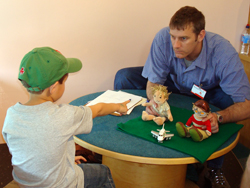What do children understand about ownership?

Children claim toys as soon as they can talk. Learning to share, and understanding when property can be given away, takes children a long time. This study examines how children (ages 2.5 to 5 years) learn the rules of ownership.
In this study, children heard two stories in which one character got a toy from another. In each story, one child is described as the owner of a toy. In one version of the story, one child wraps up one of their toys and gives it to another child at a birthday party. In another version of the story, the child brings the toy to the park, and a second child steals it. After each story, we asked children questions to see which character they thought “owned” the toy at the end of the story (for example, “Can the thief take the toy home?” or “Does the birthday girl need to give the toy back?”).
Characters in different versions of the stories also expressed emotions - the thief sometimes said “This is great!” or the victim might say “Oh no!” We wanted to know whether these variations might change how children interpreted the events in the stories.
We found that children of all ages usually thought that the thief should not be able to keep the toy. However, 2-3 year-olds often believed that the birthday-girl or birthday-boy should also give their present back at the end of the story. These younger children tended to think that the first person who had the toy should get to keep it, regardless of the circumstances. However, 4-5 year-olds often said that the birthday-girl or –boy could keep the toy but that the thief could not. The 4 year-olds were also more likely to say that an adult, but not a child, could keep a stolen object.
This study showed that children’s understanding of ownership and property continues to mature, even up to five years of age. Young children often believe that whoever has an object first should be able to keep it, which may make sharing with others challenging for them. Although this is an important social skill for older children and adults, young children may have very different opinions about sharing, taking, and giving.
This research has helped us learn more about how and when children learn the rules of ownership and how children apply these rules to everyday situations.
For more information about this research, contact Dr. Peter Blake, Living Laboratory collaborator and Director of the Social Development and Learning Lab at Boston University.
Resources:
Try it at the Museum

Mag-neato Engineering!
Observe your child building with the "mag-neatos" (magnet ball and stick toys) on the second floor of the Discovery Center.
When playing, does your child share or trade mag-neatos with other kids? Is your child particular about the type of magneatos they are willing to share (e.g. balls are in high demand, so do they seem more willing to share sticks)?
Does your child seem to have different ideas about what is fair when it comes to sharing, depending on if they were playing first with a toy, or they are joining in play with another child who was there before them?
Try it at Home
The unhappy giver?
Using dolls and a toy, tell your child a story about gift-giving at a birthday party. Then ask your child how they think each character feels.
Does your child think the gift-giver is happy or sad? Who does your child think the gift should go home with after the party, the birthday girl/boy or the gift-giver?
Do more toys make it easier to share?
When your child is playing with peers, try to change the number of toys available. If there are 3 children and 2 toys, will there be more fighting or more sharing?
What if there are more toys than children? Does your child seem more willing to share when there are more toys, or fewer toys present?